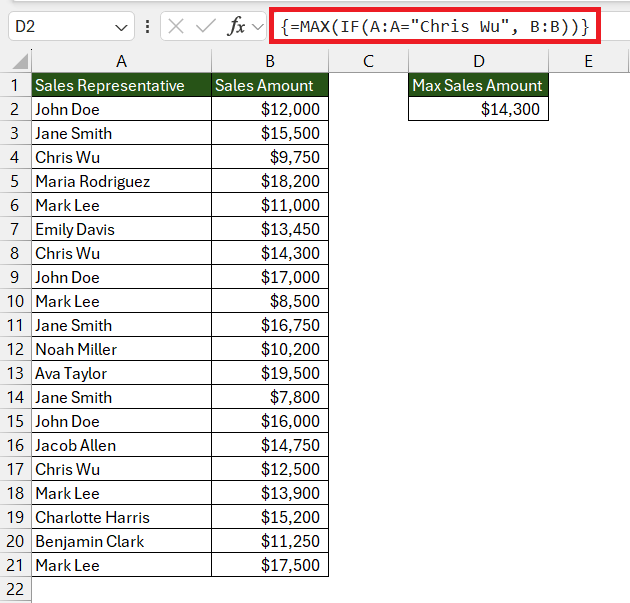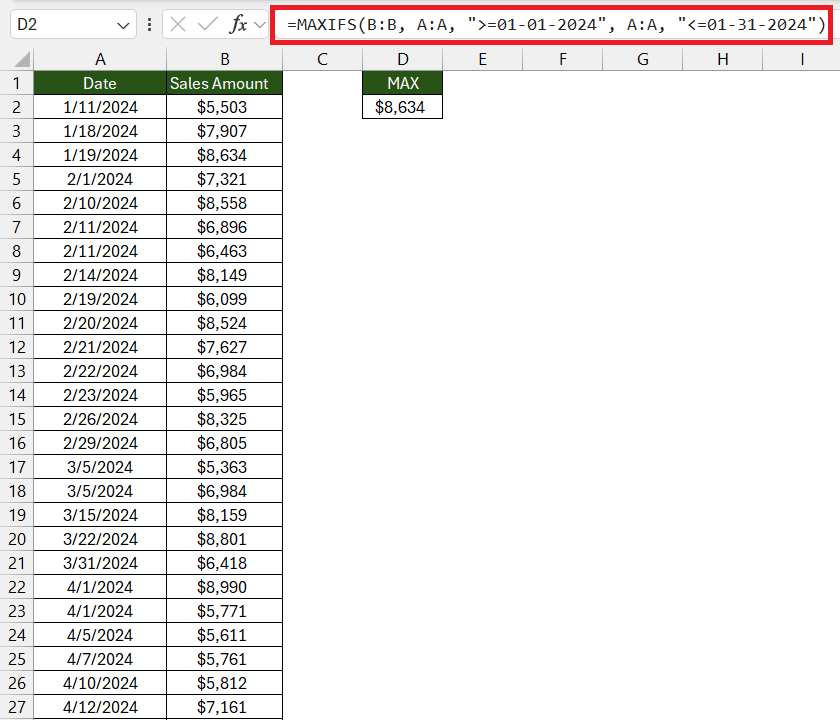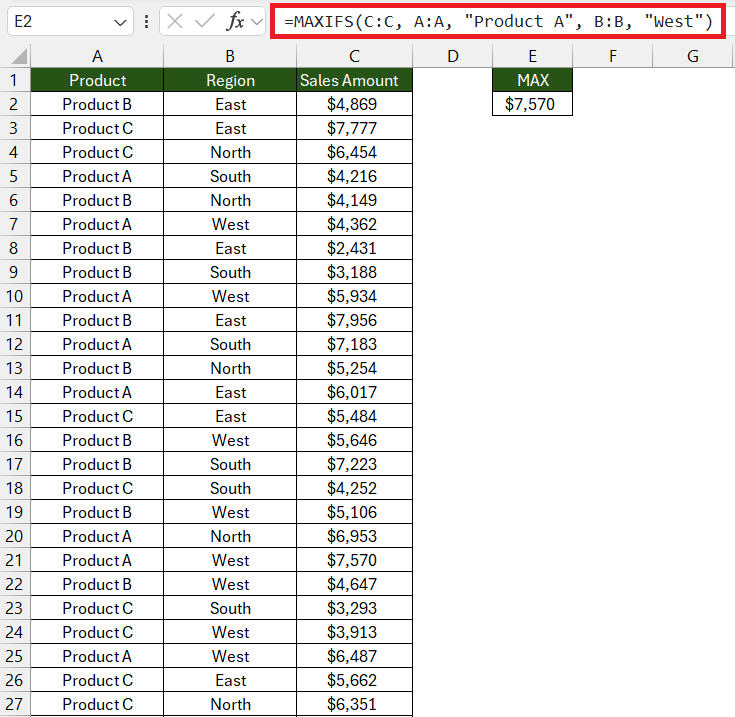Microsoft Excel‘s “MAXIF” technique and the MAXIFS function are indispensable tools for sifting through extensive datasets to find the highest values that meet specific criteria. While “MAXIF” combines MAX and IF for single conditions, MAXIFS offers a more advanced solution, handling multiple conditions with ease.
Key Takeaways
- Achieve “MAXIF” functionality by combining MAX and IF functions for single-criterion maximum value calculations in Excel.
- Introduced in Excel 2016, MAXIFS function allows multi-criteria maximum value evaluations, enhancing data analysis.
- For both methods, match the sizes of “max range” and “criteria ranges”. Use named ranges and dataset filtering for better performance and formula clarity.
- Ideal for financial analysis and data mining, these techniques offer efficient, precise conditional maximum value extraction.
Download the spreadsheet and follow along with the tutorial on How to master MAXIF and MAXIFS function in Excel – Download excel workbookMAXIF-function-in-Excel.xlsx
Table of Contents
Introduction to MAXIF and MAXIFS
Unraveling Excel’s MAXIF trick
When you’re managing a lot of data in Excel, finding the highest values under specific conditions is like finding a needle in a haystack. But don’t worry, Excel MAX-IF trick is here to help you out. This nifty little workaround involves combining the MAX function with the IF function, empowering you to calculate maximum values that meet certain criteria – without a sweat!
MAXIFS: The Function for Maximum Criteria-Based Efficiency
MAXIFS function elevates your Excel game by allowing you to extract the maximum value from your datasets based on multiple, nuanced criteria. Introduced in Excel 2016, this function is the advanced sibling of MAXIF, built for those of you who need more than just one condition to sort through your data. With MAXIFS at your disposal, they can set various parameters across multiple ranges and let Excel do the heavy lifting to pinpoint the top numbers that meet all their specified conditions.
The Mechanics of MAXIF in Excel
The MAXIF function, as commonly referred to, does not exist as a standalone function in Excel. However, the functionality that users often seek with a “MAXIF” operation—finding the maximum value in a range based on a specific criterion—can be accomplished through a combination of other Excel functions. Specifically, this is achieved using an array formula with the MAX function combined with an IF statement.
Since Excel 2019 and Office 365, users might prefer the MAXIFS function for this purpose, which directly supports multiple criteria. For those using earlier versions of Excel or looking for a single-criterion solution, the MAX and IF combination is the go-to approach.
Using MAX and IF Together
Before the introduction of MAXIFS, to replicate a “MAXIF” behavior, you would use an array formula that combines MAX with IF. This method allows you to specify conditions under which to evaluate the maximum value.
The array formula syntax using MAX and IF looks like this:
{=MAX(IF(criteria_range = criteria, max_range))}
- criteria_range: The range of cells that you evaluate for your condition.
- criteria: The condition that cells in the criteria_range must meet.
- max_range: The range of cells from which to find the maximum value, corresponding to where the criteria argument are true.
This formula must be entered as an array formula in Excel versions prior to Excel 365. To do this, press Ctrl+Shift+Enter instead of just Enter after typing your formula. Excel will automatically wrap your formula with curly braces {}, indicating it’s an array formula. In Excel 365 and later, dynamic arrays remove the need for this step.
Suppose you have sales data in two columns: Column A contains salesperson names, and Column B contains sales amounts. To find the highest sales amount by a specific salesperson, say “John”, you would use:
{=MAX(IF(A:A=”Chris Wu”, B:B))}
This formula checks each cell in Column A to see if it matches “Chris Wu”. If it does, the corresponding cell in Column B is considered in the calculation to find the maximum value.
Harnessing the Power of MAXIFS for Multi-Criteria Analysis
The MAXIFS function in Excel is a statistical function designed to find the maximum value among cells specified by a given set of conditions or criteria. It was introduced in Excel 2019 and Office 365 and represents an extension of the MAX function, allowing for more complex queries where the maximum value is determined based on multiple criteria.
The MAXIFS function syntax is straightforward and logical:
=MAXIFS(max_range, criteria_range1, criteria1, [criteria_range2, criteria2], …)
- max_range: The actual range of cells to consider for the maximum value.
- criteria_range1: The set of cells to evaluate with criteria1.
- criteria1: The condition that must be met in the criteria_range1.
- criteria_range2, criteria2, etc. (optional): Additional ranges and criteria can be included for more complex conditions.
For example, if someone needs to find the highest sales number in January, the formula might look like this:
=MAXIFS(B:B, A:A, “>=01-01-2024”, A:A, “<=01-31-2024”)
For a clearer understanding, consider another example. Suppose you want to find the highest sales amount in the West region for Product A. The MAXIFS function will look something like this:
=MAXIFS(C:C, A:A, “Product A”, B:B, “West”)
In this example, SalesAmounts is the max_range, and there are two criteria: Regions must be “West”, and Products must be “Product A”.
Tips and Tricks for Optimizing Your MAXIF & MAXIFS Experience
Must-Know Caveats When Working with MAXIF/MAXIFS Functions
When deploying MAXIF or MAXIFS in Excel, it’s important to navigate the nuances to avoid common pitfalls. A must-know caveat is that these functions require “max range” and “criteria ranges” to be of equal size and shape.
Additionally, ensure that criteria are entered correctly; even minor missteps in syntax or range references can throw off results. It’s also essential to keep in mind that MAXIFS is case-insensitive and does not match wildcards when determining the max value.
Performance Hacks for Excel Veterans: MAXIF/MAXIFS Edition
For Excel veterans on a constant quest for efficiency, mastering a few performance hacks can make handling MAXIF and MAXIFS a breeze. Using named ranges can speed up formula writing and data management.
It’s wise to apply these functions on filtered datasets to improve calculation speed when working with large volumes. Also, consider using helper columns to simplify complex criteria, which can enhance Excel’s performance and maintain spreadsheet clarity.
Creative Applications of MAXIF and MAXIFS
Time-Saving Techniques for Financial Analysis Using MAXIFS
Financial analysis demands precision and efficiency. MAXIFS can be a time-saver, helping financial analysts quickly identify peak performances or maximum values under specific financial conditions. With techniques like pinpointing the quarter with the highest sales or the top investment returns within a particular risk bracket, MAXIFS streamlines financial data interrogation, saving analysts precious time without sacrificing the thoroughness their work requires.
Transforming Data Mining with MAXIF’s Conditional Might
The conditional strength of MAXIF revolutionizes the data mining process by providing the analytical might to distill vast amounts of data down to the most relevant high-value insights. Whether they’re seeking the most significant customer transactions under certain market conditions or the peak usage times on a network, MAXIF equips them with the power to draw out these critical data points with tailored, conditional formulas, thus transforming their approach to analysis and decision-making.
Frequently Asked Questions
How do I use Maxifs in Excel?
To use MAXIFS in Excel, specify the range with the maximum value they’re seeking, followed by at least one range and its associated criteria. The formula structure looks like =MAXIFS(max_range, criteria_range1, criteria1, [criteria_range2], [criteria2], ...). Just replace max_range with the cells containing potential maximum values and criteria_range with the cells they want to evaluate against criteria.
What is the Difference Between MAXIF and MAXIFS?
While MAXIF is a combination of the MAX and IF functions rigged together to evaluate a single condition, MAXIFS is a dedicated function that allows for multiple conditions out of the box. The key difference lies in MAXIFS’s native ability to handle and process several criteria ranges at once, providing a robust tool for complex data scenarios compared to the more manually constructed MAXIF.
Can I Use MAXIFS to Aggregate Non-Numeric Data?
No, MAXIFS is designed to aggregate only numeric data as it’s used to find the maximum value based on specified criteria. Non-numeric data, like text or Boolean values, can’t be evaluated for a maximum in the same way, so MAXIFS won’t work with such data types. They’ll need to use other functions suitable for handling non-numeric aggregation.
Why does the maxifs return zero in excel?
MAXIFS may return zero in Excel if no cells meet the specified criteria or if the criteria ranges don’t match the max range in size and shape. It can also occur if the max range is empty, contains text or non-numeric values, or only has zeros or negative numbers. They should double-check their criteria and ranges to ensure accuracy.
What is the alternative to maxifs in excel?
For versions of Excel that don’t support MAXIFS, they can use an array formula combining MAX and IF functions as an alternative. Another option is to use a combination of the SUMPRODUCT and MAX functions to mimic the MAXIFS functionality. Both alternatives allow them to evaluate multiple conditions to find a maximum value.
John Michaloudis is a former accountant and finance analyst at General Electric, a Microsoft MVP since 2020, an Amazon #1 bestselling author of 4 Microsoft Excel books and teacher of Microsoft Excel & Office over at his flagship MyExcelOnline Academy Online Course.










